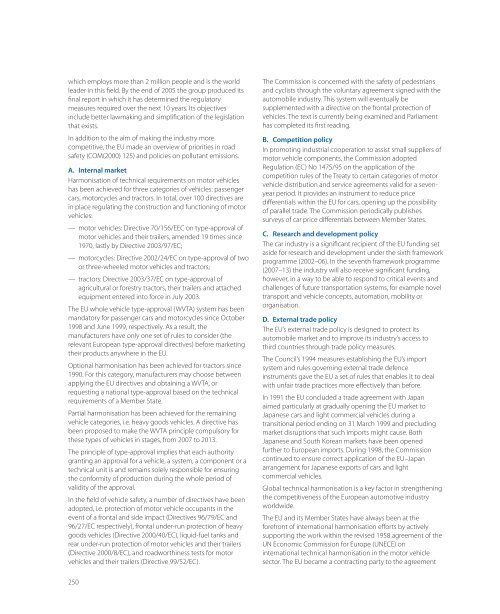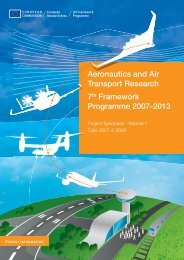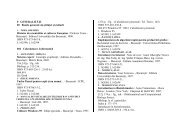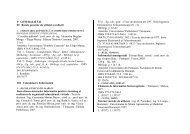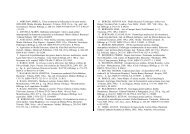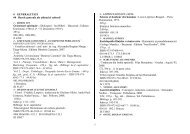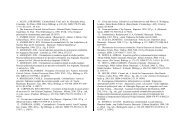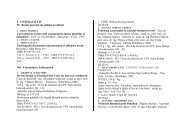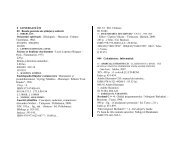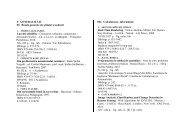Fact Sheets on the European Union â 2 - EU Bookshop - Europa
Fact Sheets on the European Union â 2 - EU Bookshop - Europa
Fact Sheets on the European Union â 2 - EU Bookshop - Europa
Create successful ePaper yourself
Turn your PDF publications into a flip-book with our unique Google optimized e-Paper software.
which employs more than 2 milli<strong>on</strong> people and is <strong>the</strong> world<br />
leader in this field. By <strong>the</strong> end of 2005 <strong>the</strong> group produced its<br />
final report in which it has determined <strong>the</strong> regulatory<br />
measures required over <strong>the</strong> next 10 years. Its objectives<br />
include better lawmaking and simplificati<strong>on</strong> of <strong>the</strong> legislati<strong>on</strong><br />
that exists.<br />
In additi<strong>on</strong> to <strong>the</strong> aim of making <strong>the</strong> industry more<br />
competitive, <strong>the</strong> <strong>EU</strong> made an overview of priorities in road<br />
safety (COM(2000) 125) and policies <strong>on</strong> pollutant emissi<strong>on</strong>s.<br />
A. Internal market<br />
Harm<strong>on</strong>isati<strong>on</strong> of technical requirements <strong>on</strong> motor vehicles<br />
has been achieved for three categories of vehicles: passenger<br />
cars, motorcycles and tractors. In total, over 100 directives are<br />
in place regulating <strong>the</strong> c<strong>on</strong>structi<strong>on</strong> and functi<strong>on</strong>ing of motor<br />
vehicles:<br />
— motor vehicles: Directive 70/156/EEC <strong>on</strong> type-approval of<br />
motor vehicles and <strong>the</strong>ir trailers, amended 19 times since<br />
1970, lastly by Directive 2003/97/EC;<br />
— motorcycles: Directive 2002/24/EC <strong>on</strong> type-approval of two<br />
or three-wheeled motor vehicles and tractors;<br />
— tractors: Directive 2003/37/EC <strong>on</strong> type-approval of<br />
agricultural or forestry tractors, <strong>the</strong>ir trailers and attached<br />
equipment entered into force in July 2003.<br />
The <strong>EU</strong> whole vehicle type-approval (WVTA) system has been<br />
mandatory for passenger cars and motorcycles since October<br />
1998 and June 1999, respectively. As a result, <strong>the</strong><br />
manufacturers have <strong>on</strong>ly <strong>on</strong>e set of rules to c<strong>on</strong>sider (<strong>the</strong><br />
relevant <strong>European</strong> type-approval directives) before marketing<br />
<strong>the</strong>ir products anywhere in <strong>the</strong> <strong>EU</strong>.<br />
Opti<strong>on</strong>al harm<strong>on</strong>isati<strong>on</strong> has been achieved for tractors since<br />
1990. For this category, manufacturers may choose between<br />
applying <strong>the</strong> <strong>EU</strong> directives and obtaining a WVTA, or<br />
requesting a nati<strong>on</strong>al type-approval based <strong>on</strong> <strong>the</strong> technical<br />
requirements of a Member State.<br />
Partial harm<strong>on</strong>isati<strong>on</strong> has been achieved for <strong>the</strong> remaining<br />
vehicle categories, i.e. heavy goods vehicles. A directive has<br />
been proposed to make <strong>the</strong> WVTA principle compulsory for<br />
<strong>the</strong>se types of vehicles in stages, from 2007 to 2013.<br />
The principle of type-approval implies that each authority<br />
granting an approval for a vehicle, a system, a comp<strong>on</strong>ent or a<br />
technical unit is and remains solely resp<strong>on</strong>sible for ensuring<br />
<strong>the</strong> c<strong>on</strong>formity of producti<strong>on</strong> during <strong>the</strong> whole period of<br />
validity of <strong>the</strong> approval.<br />
In <strong>the</strong> field of vehicle safety, a number of directives have been<br />
adopted, i.e. protecti<strong>on</strong> of motor vehicle occupants in <strong>the</strong><br />
event of a fr<strong>on</strong>tal and side impact (Directives 96/79/EC and<br />
96/27/EC respectively), fr<strong>on</strong>tal under-run protecti<strong>on</strong> of heavy<br />
goods vehicles (Directive 2000/40/EC), liquid-fuel tanks and<br />
rear under-run protecti<strong>on</strong> of motor vehicles and <strong>the</strong>ir trailers<br />
(Directive 2000/8/EC), and roadworthiness tests for motor<br />
vehicles and <strong>the</strong>ir trailers (Directive 99/52/EC).<br />
The Commissi<strong>on</strong> is c<strong>on</strong>cerned with <strong>the</strong> safety of pedestrians<br />
and cyclists through <strong>the</strong> voluntary agreement signed with <strong>the</strong><br />
automobile industry. This system will eventually be<br />
supplemented with a directive <strong>on</strong> <strong>the</strong> fr<strong>on</strong>tal protecti<strong>on</strong> of<br />
vehicles. The text is currently being examined and Parliament<br />
has completed its first reading.<br />
B. Competiti<strong>on</strong> policy<br />
In promoting industrial cooperati<strong>on</strong> to assist small suppliers of<br />
motor vehicle comp<strong>on</strong>ents, <strong>the</strong> Commissi<strong>on</strong> adopted<br />
Regulati<strong>on</strong> (EC) No 1475/95 <strong>on</strong> <strong>the</strong> applicati<strong>on</strong> of <strong>the</strong><br />
competiti<strong>on</strong> rules of <strong>the</strong> Treaty to certain categories of motor<br />
vehicle distributi<strong>on</strong> and service agreements valid for a sevenyear<br />
period. It provides an instrument to reduce price<br />
differentials within <strong>the</strong> <strong>EU</strong> for cars, opening up <strong>the</strong> possibility<br />
of parallel trade. The Commissi<strong>on</strong> periodically publishes<br />
surveys of car price differentials between Member States.<br />
C. Research and development policy<br />
The car industry is a significant recipient of <strong>the</strong> <strong>EU</strong> funding set<br />
aside for research and development under <strong>the</strong> sixth framework<br />
programme (2002–06). In <strong>the</strong> seventh framework programme<br />
(2007–13) <strong>the</strong> industry will also receive significant funding,<br />
however, in a way to be able to resp<strong>on</strong>d to critical events and<br />
challenges of future transportati<strong>on</strong> systems, for example novel<br />
transport and vehicle c<strong>on</strong>cepts, automati<strong>on</strong>, mobility or<br />
organisati<strong>on</strong>.<br />
D. External trade policy<br />
The <strong>EU</strong>’s external trade policy is designed to protect its<br />
automobile market and to improve its industry’s access to<br />
third countries through trade policy measures.<br />
The Council’s 1994 measures establishing <strong>the</strong> <strong>EU</strong>’s import<br />
system and rules governing external trade defence<br />
instruments gave <strong>the</strong> <strong>EU</strong> a set of rules that enables it to deal<br />
with unfair trade practices more effectively than before.<br />
In 1991 <strong>the</strong> <strong>EU</strong> c<strong>on</strong>cluded a trade agreement with Japan<br />
aimed particularly at gradually opening <strong>the</strong> <strong>EU</strong> market to<br />
Japanese cars and light commercial vehicles during a<br />
transiti<strong>on</strong>al period ending <strong>on</strong> 31 March 1999 and precluding<br />
market disrupti<strong>on</strong>s that such imports might cause. Both<br />
Japanese and South Korean markets have been opened<br />
fur<strong>the</strong>r to <strong>European</strong> imports. During 1998, <strong>the</strong> Commissi<strong>on</strong><br />
c<strong>on</strong>tinued to ensure correct applicati<strong>on</strong> of <strong>the</strong> <strong>EU</strong>–Japan<br />
arrangement for Japanese exports of cars and light<br />
commercial vehicles.<br />
Global technical harm<strong>on</strong>isati<strong>on</strong> is a key factor in streng<strong>the</strong>ning<br />
<strong>the</strong> competitiveness of <strong>the</strong> <strong>European</strong> automotive industry<br />
worldwide.<br />
The <strong>EU</strong> and its Member States have always been at <strong>the</strong><br />
forefr<strong>on</strong>t of internati<strong>on</strong>al harm<strong>on</strong>isati<strong>on</strong> efforts by actively<br />
supporting <strong>the</strong> work within <strong>the</strong> revised 1958 agreement of <strong>the</strong><br />
UN Ec<strong>on</strong>omic Commissi<strong>on</strong> for Europe (UNECE) <strong>on</strong><br />
internati<strong>on</strong>al technical harm<strong>on</strong>isati<strong>on</strong> in <strong>the</strong> motor vehicle<br />
sector. The <strong>EU</strong> became a c<strong>on</strong>tracting party to <strong>the</strong> agreement<br />
250


